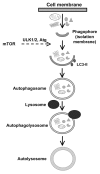Autophagy and cardiovascular aging: lesson learned from rapamycin
- PMID: 22580468
- PMCID: PMC3368861
- DOI: 10.4161/cc.20317
Autophagy and cardiovascular aging: lesson learned from rapamycin
Abstract
The biological aging process is commonly associated with increased risk of cardiovascular diseases. Several theories have been put forward for aging-associated deterioration in ventricular function, including attenuation of growth hormone (insulin-like growth factors and insulin) signaling, loss of DNA replication and repair, histone acetylation and accumulation of reactive oxygen species. Recent evidence has depicted a rather unique role of autophagy as another important pathway in the regulation of longevity and senescence. Autophagy is a predominant cytoprotective (rather than self-destructive) process. It carries a prominent role in determination of lifespan. Reduced autophagy has been associated with aging, leading to accumulation of dysfunctional or damaged proteins and organelles. To the contrary, measures such as caloric restriction and exercise may promote autophagy to delay aging and associated comorbidities. Stimulation of autophagy using rapamycin may represent a novel strategy to prolong lifespan and combat aging-associated diseases. Rapamycin regulates autophagy through inhibition of the nutrient-sensing molecule mammalian target of rapamycin (mTOR). Inhibition of mTOR through rapamycin and caloric restriction promotes longevity. The purpose of this review is to recapitulate some of the recent advances in an effort to better understand the interplay between rapamycin-induced autophagy and decelerating cardiovascular aging.
Figures


Similar articles
-
ROS Promote Ox-LDL-Induced Platelet Activation by Up-Regulating Autophagy Through the Inhibition of the PI3K/AKT/mTOR Pathway.Cell Physiol Biochem. 2018;50(5):1779-1793. doi: 10.1159/000494795. Epub 2018 Nov 1. Cell Physiol Biochem. 2018. PMID: 30384368
-
TOR Signaling Pathway in Cardiac Aging and Heart Failure.Biomolecules. 2021 Jan 27;11(2):168. doi: 10.3390/biom11020168. Biomolecules. 2021. PMID: 33513917 Free PMC article. Review.
-
Hepatitis C virus inhibits AKT-tuberous sclerosis complex (TSC), the mechanistic target of rapamycin (MTOR) pathway, through endoplasmic reticulum stress to induce autophagy.Autophagy. 2013 Feb 1;9(2):175-95. doi: 10.4161/auto.22791. Epub 2012 Nov 20. Autophagy. 2013. PMID: 23169238 Free PMC article.
-
mTOR inactivation by ROS-JNK-p53 pathway plays an essential role in psedolaric acid B induced autophagy-dependent senescence in murine fibrosarcoma L929 cells.Eur J Pharmacol. 2013 Sep 5;715(1-3):76-88. doi: 10.1016/j.ejphar.2013.05.051. Epub 2013 Jun 26. Eur J Pharmacol. 2013. PMID: 23810968
-
The Target of Rapamycin Signalling Pathway in Ageing and Lifespan Regulation.Genes (Basel). 2020 Sep 3;11(9):1043. doi: 10.3390/genes11091043. Genes (Basel). 2020. PMID: 32899412 Free PMC article. Review.
Cited by
-
Apatinib Through Activating the RhoA/ROCK Signaling Pathway to Cause Dysfunction of Vascular Smooth Muscle Cells.Appl Biochem Biotechnol. 2022 Nov;194(11):5367-5385. doi: 10.1007/s12010-022-04020-5. Epub 2022 Jul 1. Appl Biochem Biotechnol. 2022. PMID: 35776338
-
HIF-1α/Beclin1-Mediated Autophagy Is Involved in Neuroprotection Induced by Hypoxic Preconditioning.J Mol Neurosci. 2018 Oct;66(2):238-250. doi: 10.1007/s12031-018-1162-7. Epub 2018 Sep 10. J Mol Neurosci. 2018. PMID: 30203298 Free PMC article.
-
RETRACTED: Akt2 knockout alleviates prolonged caloric restriction-induced change in cardiac contractile function through regulation of autophagy.J Mol Cell Cardiol. 2014 Jun;71:81-91. doi: 10.1016/j.yjmcc.2013.12.010. Epub 2013 Dec 22. J Mol Cell Cardiol. 2014. Retraction in: J Mol Cell Cardiol. 2023 Apr;177:63. doi: 10.1016/j.yjmcc.2023.03.005. PMID: 24368095 Free PMC article. Retracted.
-
M(o)TOR of aging: MTOR as a universal molecular hypothalamus.Aging (Albany NY). 2013 Jul;5(7):490-4. doi: 10.18632/aging.100580. Aging (Albany NY). 2013. PMID: 23872658 Free PMC article.
-
TOR-centric view on insulin resistance and diabetic complications: perspective for endocrinologists and gerontologists.Cell Death Dis. 2013 Dec 12;4(12):e964. doi: 10.1038/cddis.2013.506. Cell Death Dis. 2013. PMID: 24336084 Free PMC article. Review.
References
-
- Lakatta EG. Cardiovascular regulatory mechanisms in advanced age. Physiol Rev. 1993;73:413–67. - PubMed
-
- Roger VL, Go AS, Lloyd-Jones DM, Adams RJ, Berry JD, Brown TM, et al. American Heart Association Statistics Committee and Stroke Statistics Subcommittee Heart disease and stroke statistics--2011 update: a report from the American Heart Association. Circulation. 2011;123:e18–209. doi: 10.1161/CIR.0b013e3182009701. - DOI - PMC - PubMed
Publication types
MeSH terms
Substances
Grants and funding
LinkOut - more resources
Full Text Sources
Medical
Miscellaneous
